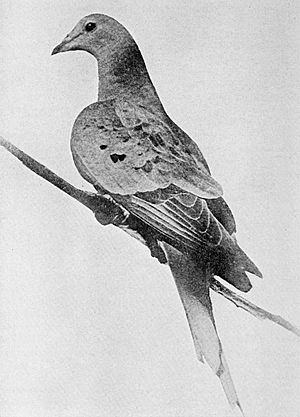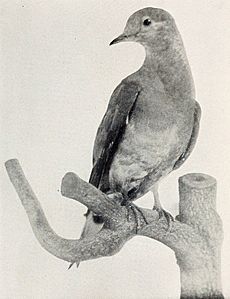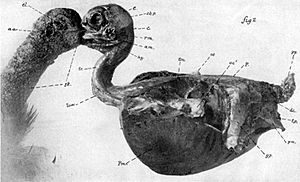Martha (passenger pigeon) facts for kids

Martha in her enclosure, 1914
|
|
| Species | Passenger pigeon |
|---|---|
| Sex | Female |
| Hatched | c. 1885 |
| Died | September 1, 1914 (aged 28–29) Cincinnati Zoo |
| Resting place | National Museum of Natural History |
| Known for | Last known living passenger pigeon |
Martha (born around 1885 – died September 1, 1914) was the very last known passenger pigeon alive. Her scientific name was Ectopistes migratorius. She was given the name "Martha" to honor Martha Washington, who was the first First Lady.
Martha's Early Life
The story of Martha's early life can be a bit confusing. Most people agree that the last group of passenger pigeons was kept by Professor Charles Otis Whitman at the University of Chicago.
Professor Whitman got his pigeons from David Whittaker in Wisconsin. He received six birds, and two of them had a baby pigeon around 1885. This baby pigeon was Martha. Professor Whitman studied these pigeons to learn about their behavior. He also tried to breed them, hoping to save the species. He even tried to have rock doves act as foster parents for passenger pigeon eggs, but it didn't work.
In 1902, Professor Whitman sent Martha to the Cincinnati Zoo. However, some people believe Martha was actually born at the Cincinnati Zoo in 1885. They say the zoo bought three pairs of passenger pigeons in 1877. These birds were first kept so visitors could see a local bird up close, not because they were rare.
Life at the Cincinnati Zoo
By November 1907, Martha and two male pigeons at the Cincinnati Zoo were the only known passenger pigeons left. Other captive males in Milwaukee had died. One of Martha's male companions at the Cincinnati Zoo died in April 1909. The last male died on July 10, 1910.
This meant Martha became the only known living passenger pigeon. She became very famous because of this. People offered a $1000 reward to anyone who could find a mate for her. This brought even more visitors to the zoo to see her.
A few years before she died, Martha became weak from an illness. The zoo built a lower perch for her because she couldn't reach her old one anymore. Martha died at 1 p.m. on September 1, 1914. She passed away from old age. Her body was found on the floor of her cage. Martha was likely around 29 years old when she died.
After Martha's Death
After Martha died, her body was quickly taken to the Cincinnati Ice Company. She was frozen in a large block of ice, weighing about 136 kilograms (300 pounds). Then, she was sent by train to the Smithsonian Institution in Washington, D.C. She arrived there on September 4, 1914.
When she died, Martha was losing some of her old feathers and growing new ones. So, she was missing a few feathers, including some long tail feathers. At the Smithsonian, William Palmer carefully removed her skin. Nelson R. Wood then prepared her skin to be displayed. Her internal organs were also studied and saved by the National Museum of Natural History.
From the 1920s to the early 1950s, Martha was shown in the Bird Hall at the National Museum of Natural History. She was displayed with a male passenger pigeon that had been shot in Minnesota in 1873. Later, she was part of the "Birds of the World" exhibit from 1956 to 1999.
Martha left the Smithsonian twice during this time. In 1966, she was shown at a conservation conference. In June 1974, she went back to the Cincinnati Zoo for a special memorial event. When the "Birds of the World" exhibit closed, Martha was taken off display. She was later shown in a special exhibit at the Cincinnati Zoo. Martha was back on display at the Smithsonian from June 2014 to September 2015 for an exhibit called Once There Were Billions.
Martha's Importance
Martha has become a very important symbol. She reminds us of the danger of extinction, which is when a whole species dies out. At a conservation conference in 1966, Martha was used as a mascot to show how important it is to protect animals.
One historian described Martha's preserved body as a "monument." It's a physical reminder of the living bird and the idea of extinction itself. Many authors who write about extinction have made a special trip to see her remains.
John Herald, a bluegrass singer, wrote a song about Martha and the passenger pigeon's extinction. He called it "Martha (Last of the Passenger Pigeons)". In 2019, an author named Greg Benchwick wrote a children's book about Martha.





